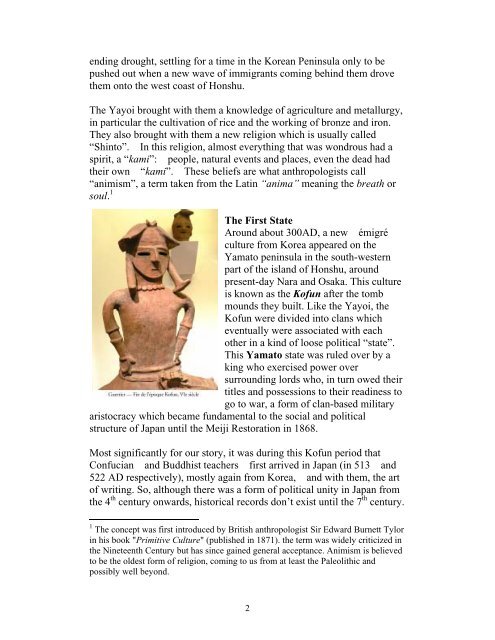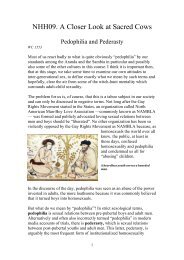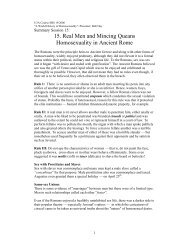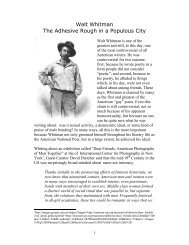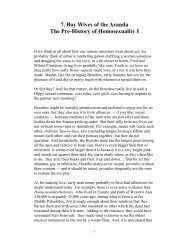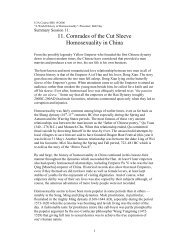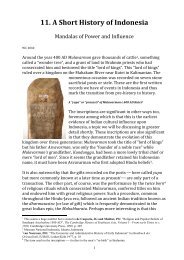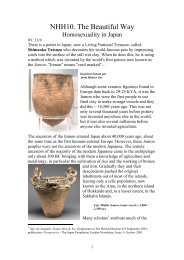10. The Beautiful Way Homosexuality in Japan
10. The Beautiful Way Homosexuality in Japan
10. The Beautiful Way Homosexuality in Japan
Create successful ePaper yourself
Turn your PDF publications into a flip-book with our unique Google optimized e-Paper software.
end<strong>in</strong>g drought, settl<strong>in</strong>g for a time <strong>in</strong> the Korean Pen<strong>in</strong>sula only to be<br />
pushed out when a new wave of immigrants com<strong>in</strong>g beh<strong>in</strong>d them drove<br />
them onto the west coast of Honshu.<br />
<strong>The</strong> Yayoi brought with them a knowledge of agriculture and metallurgy,<br />
<strong>in</strong> particular the cultivation of rice and the work<strong>in</strong>g of bronze and iron.<br />
<strong>The</strong>y also brought with them a new religion which is usually called<br />
“Sh<strong>in</strong>to”. In this religion, almost everyth<strong>in</strong>g that was wondrous had a<br />
spirit, a “kami”: people, natural events and places, even the dead had<br />
their own “kami”. <strong>The</strong>se beliefs are what anthropologists call<br />
“animism”, a term taken from the Lat<strong>in</strong> “anima” mean<strong>in</strong>g the breath or<br />
soul. 1<br />
<strong>The</strong> First State<br />
Around about 300AD, a new émigré<br />
culture from Korea appeared on the<br />
Yamato pen<strong>in</strong>sula <strong>in</strong> the south-western<br />
part of the island of Honshu, around<br />
present-day Nara and Osaka. This culture<br />
is known as the Kofun after the tomb<br />
mounds they built. Like the Yayoi, the<br />
Kofun were divided <strong>in</strong>to clans which<br />
eventually were associated with each<br />
other <strong>in</strong> a k<strong>in</strong>d of loose political “state”.<br />
This Yamato state was ruled over by a<br />
k<strong>in</strong>g who exercised power over<br />
surround<strong>in</strong>g lords who, <strong>in</strong> turn owed their<br />
titles and possessions to their read<strong>in</strong>ess to<br />
go to war, a form of clan-based military<br />
aristocracy which became fundamental to the social and political<br />
structure of <strong>Japan</strong> until the Meiji Restoration <strong>in</strong> 1868.<br />
Most significantly for our story, it was dur<strong>in</strong>g this Kofun period that<br />
Confucian and Buddhist teachers first arrived <strong>in</strong> <strong>Japan</strong> (<strong>in</strong> 513 and<br />
522 AD respectively), mostly aga<strong>in</strong> from Korea, and with them, the art<br />
of writ<strong>in</strong>g. So, although there was a form of political unity <strong>in</strong> <strong>Japan</strong> from<br />
the 4 th century onwards, historical records don’t exist until the 7 th century.<br />
1 <strong>The</strong> concept was first <strong>in</strong>troduced by British anthropologist Sir Edward Burnett Tylor<br />
<strong>in</strong> his book "Primitive Culture" (published <strong>in</strong> 1871). the term was widely criticized <strong>in</strong><br />
the N<strong>in</strong>eteenth Century but has s<strong>in</strong>ce ga<strong>in</strong>ed general acceptance. Animism is believed<br />
to be the oldest form of religion, com<strong>in</strong>g to us from at least the Paleolithic and<br />
possibly well beyond.<br />
2


